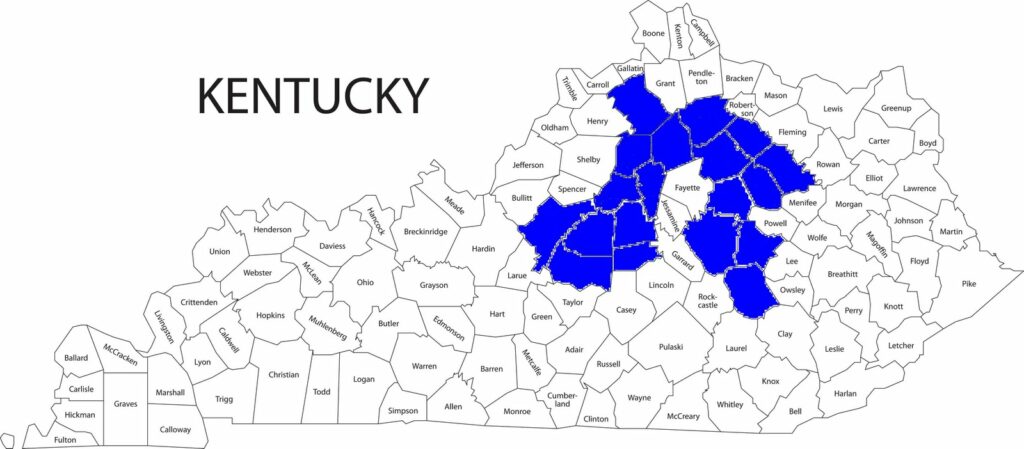 Lancaster is kind of a mess. The traffic is crazy for the size of the town, and its really difficult to get around. Maybe it was the overcast day, or the empty buildings I saw, but Lancaster kind of depressed me.
Lancaster is kind of a mess. The traffic is crazy for the size of the town, and its really difficult to get around. Maybe it was the overcast day, or the empty buildings I saw, but Lancaster kind of depressed me.
There is a pretty cool plaque on the courthouse that details the gifts of Captain William Early Buford, a veteran of the American Revolution who gave the original 20 lots and the public square in Lancaster.
Jessamine County Courthouse – Nicholasville, Ky.
 Ah, Nickytown. . . home of my good friend Peter, who serves as the primary writer for this blog. I promised him that I would wait to do Nicholasville with him, so we headed into town one evening last week. The Jessamine County Courthouse is beautiful, and is quite a complex building.
Ah, Nickytown. . . home of my good friend Peter, who serves as the primary writer for this blog. I promised him that I would wait to do Nicholasville with him, so we headed into town one evening last week. The Jessamine County Courthouse is beautiful, and is quite a complex building.
 Here at the right you can see the back of the building, which shows a lot of its complexity. I particularly like the lady justice that faces (I believe) west on the side of the courthouse. The folks in the courthouse were extremely friendly, offering to let us see the Circuit Courtroom and show us around. The courthouse was originally built in 1878, and was remodeled in 1964.
Here at the right you can see the back of the building, which shows a lot of its complexity. I particularly like the lady justice that faces (I believe) west on the side of the courthouse. The folks in the courthouse were extremely friendly, offering to let us see the Circuit Courtroom and show us around. The courthouse was originally built in 1878, and was remodeled in 1964.
I thought this little tidbit was pretty interesting. According to the county historical marker, Jessamine county was named for the Jessamine flower that grows so abundantly in the area, as well as the Jessamine Creek. Local legend apparently attributes that name to Jessamine Douglass, the daughter of an early settler to the area, who was allegedly “stealthily tomahawked” to death by a Native American as she rested on the creek. That seems to me to be a strange way to name a creek/county, but hey, who am I?
No Destination: Lincoln & Casey Counties
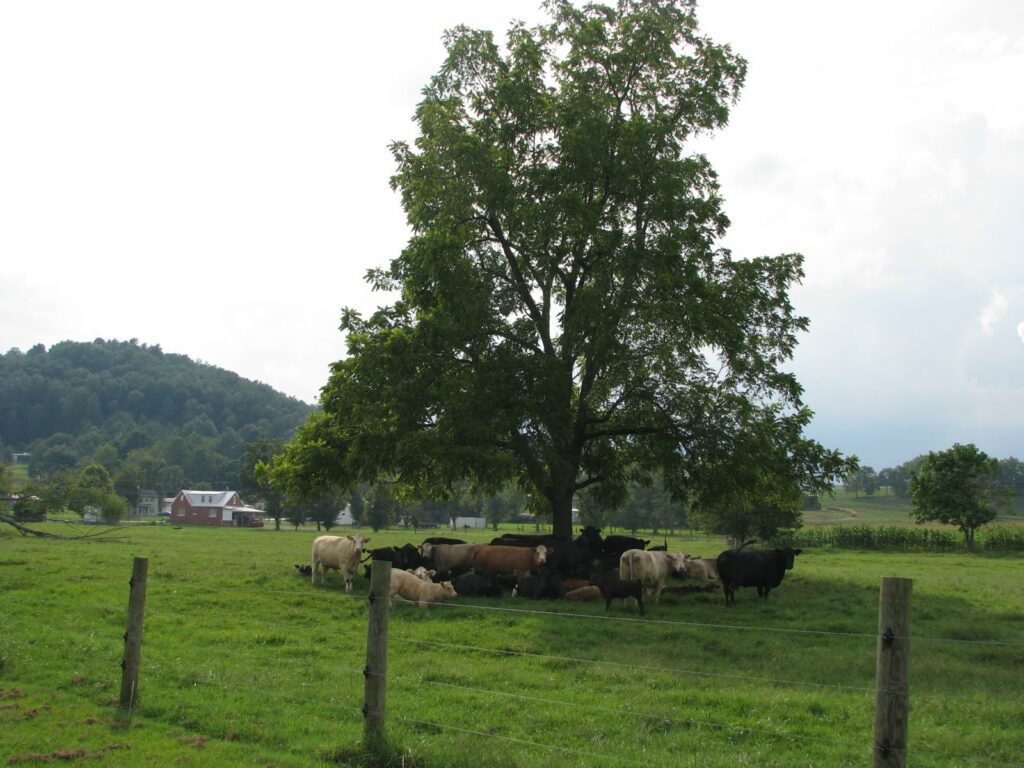
Not only was Stanford a surprise, but several areas of historic Lincoln County prompted me to stop the car.
A historic marker noting the site of McKinney’s Fort: a fort established in 1792 which became an important stop on the Cumberland Trace. The area is now known as McKinney’s Station.
Once in Casey County – just just north of Yosemite – we crossed over an unimpressive tributary of the Green River. A tree under which the cattle relaxed was, however, a beautiful site.
On the return home – but once again in Lincoln County – I spotted a town I wanted to visit: Chicken Bristle. Driving through, there was no sign evidencing the name of this small community. In this rural area, I was surprised to see an old A.M.E. [African Methodist Episcopal] church. I supposed that Chicken Bristle might have been one of the black communities that dotted the region in years past. Sure enough, Chicken Bristle was one of three black Lincoln County communities founded in the post-Civil War era.
Also in Lincoln County was the small community of Hustonville – site of what must be a crazy-scary year-round haunted house.
No Destination: Stanford

After a disappointing visit to Lancaster, I wasn’t sure what to expect upon my arrival in the county seat of Lincoln County. Adding to my dilemma was that I was immediately drawn to one of the most dilapidated strucutures: the old Baughman Mill. Built in 1884 with logs from the first steam mill in the county, the mill operated until consumer demands and and market supply changed. The mill is located next to the old L&N Depot (which FDR visited while campaigning for President in 1932). In researching for this post, I came across another picture of the old mill taken only last year; note that an entire wing has since been demolished.)
 History is very important to Stanford (and to Lincoln County). The county was one of three originally created when the Virginia legislature divided the Kentucky territory into three counties (5 counties existed in 1792 when Kentucky became a state). Stanford is the second oldest community in the state and its Main Street was once part of the Wilderness Road (making it the oldest Main Street in Kentucky).
History is very important to Stanford (and to Lincoln County). The county was one of three originally created when the Virginia legislature divided the Kentucky territory into three counties (5 counties existed in 1792 when Kentucky became a state). Stanford is the second oldest community in the state and its Main Street was once part of the Wilderness Road (making it the oldest Main Street in Kentucky).
Another neat structure was the First Presbyterian Church – the congregation was organized in 1788 and the structure (original destroyed by a 1838 tornado) was built in 1888. Pictured left, it seems oddly reminiscent of a courthouse.
But history is not all that is left for Stanford. Despite not having rail service for many years, the economy of the county seems relatively strong. The tourism director seemed quite positive and excited about the current state of the county. The optimism seemed warranted – a large, new library is under construction.
No Destination: Garrard County & Lancaster
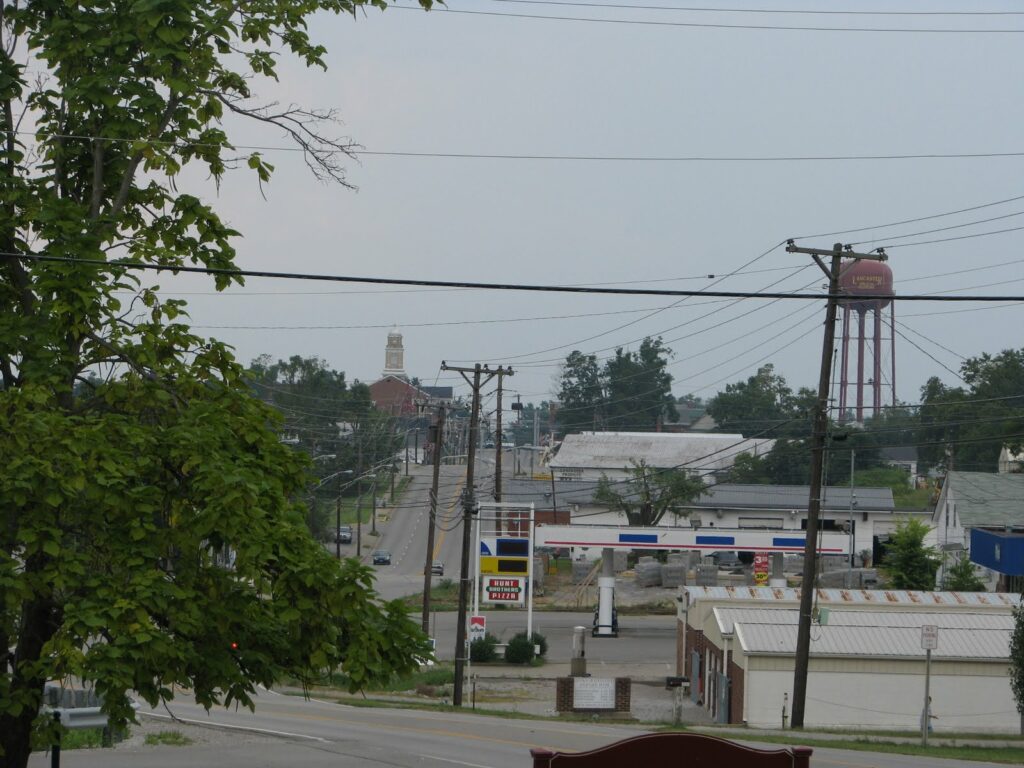
Nate often mentions how he loves approaching the county seat, scouring the horizon for the courthouse. Lancaster is the perfect example of this. The picture above was taken as we we were leaving Lancaster from the grounds of the Gov. William Owsley’s “Pleasant Retreat.” Owsley, a fiscal conservative, was a major proponent of public education, an opponent of the Mexican War (though he still, as governor, called for volunteers) and was crticized for his pardoning of Delia Webster (who had been convicted of abetting the escape of slaves).
 I had never before been past the “Pleasant Retreat,” though I have driven through Lancaster several times before. Each time, I had always been impressed by the little downtown. This time, however, I got out of my car and found walking the central area very challenging. Despite the challenges, little Lancaster had a few bright spots: First Presybyterian Church (established 1816; current structure built 1879 and pictured at right) and the old Garrard County Jail (built 1873, now the Historical Society).
I had never before been past the “Pleasant Retreat,” though I have driven through Lancaster several times before. Each time, I had always been impressed by the little downtown. This time, however, I got out of my car and found walking the central area very challenging. Despite the challenges, little Lancaster had a few bright spots: First Presybyterian Church (established 1816; current structure built 1879 and pictured at right) and the old Garrard County Jail (built 1873, now the Historical Society).
Despite these and a Farmer’s Market (coming soon) and a revitalization of the Grand Theater, Lancaster left me a little disappointed. Apparently, I am not alone. A conversation today with a Garrard Countian revealed the most sobering fact of all: No grocery stores (a sore spot for this particular resident, at least).
No Destination: Nicholasville
I traveled with Nate on a Courthouse tour and walked around four communities. Often, I would get out of the car a few blocks away from the courthouse and explore the little towns for about 20 minutes. Also, No Destinations will begin to examine the landmarks found rather than only the day’s journey. This should allow me to delve into each discovery a little more.
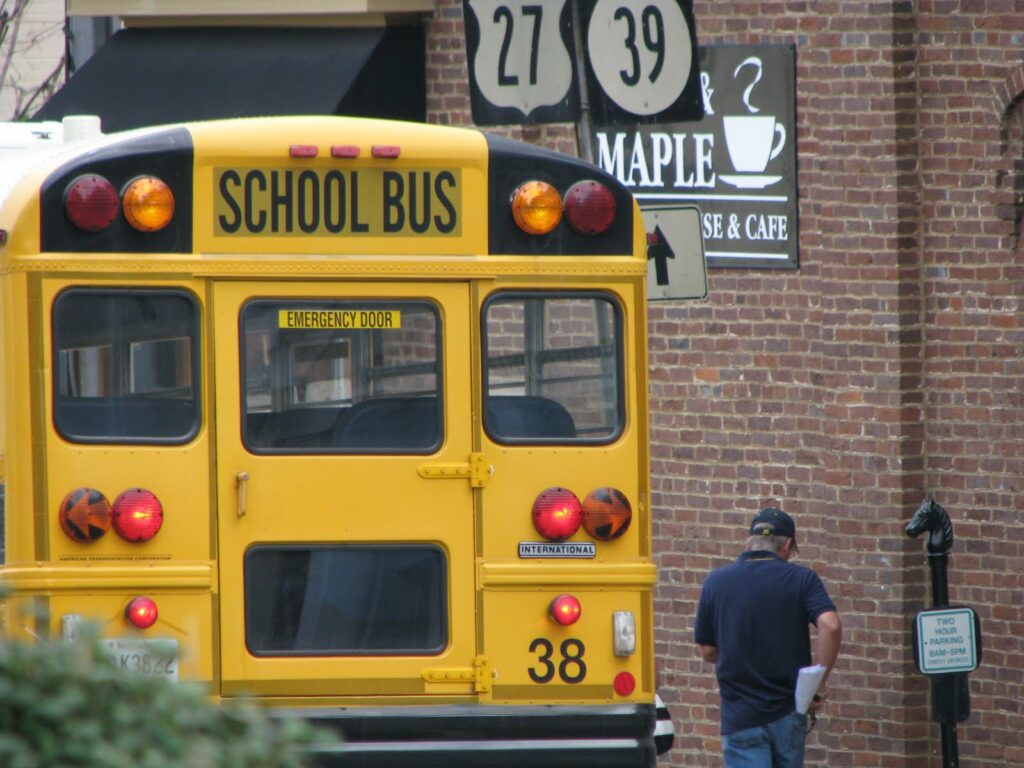
Nicholasville was named after Col. George Nicholas, a veteran of the Revolutionary War who authored Kentucky’s first Constitution. The city was laid out in 1798 – the same year in which Jessamine was carved from Fayette County. A number of historic churches are within a block of the courthouse, but it is the courthouse that dominates this little ville.
Being a resident of little Nicholasville – one of Lexington’s bedroom communities – is both a blessing and a curse. Despite its pitfalls, however, Nicholasville’s central business district is improving and has several great little jewels. One of those jewels is Main & Maple, a small coffee house and cafe that is housed in a renovated pharmacy. I pictured a corner of Main & Maple above along with the school bus. Despite its storied past (look for a future post on the Chaumiere des Praries), I feel that this picture captures the pace and attitude of Jessamine, i.e., a working class bedroom community with schools and a few other things too.
Kentucky 120 progress
Madison County Courthouse – Richmond, Ky.
I love Main Street in Richmond. It’s hilly, and as you come into town, it all spreads out in front of you. Today it hit me what makes some downtowns prettier than others – the really nice ones are like Richmond, where all the utility lines have been put underground. It really cleans up the view.
Richmond has done a great job in mapping out its history. In the few moments I spent at the courthouse square I learned a ton. The courthouse square in Richmond has a pretty great story. According to the historic markers, during the Civil War the courthouse square was used to house Union prisoners of war. More than 4,300 soldiers were kept here for a week until they were paroled. I particularly liked this. When a confederate colonel was asked by his superiors how many had been captured, his response was “I have not counted them, but I have a ten-acre lot full.”
The bust pictured above is a pioneer monument erected in 1906 by Richmond native David R. Francis, who was Mayor of St. Louis, Governor of Missouri, an ambassador to Russia and the U.S. Secretary of the Interior.
Also, a plaque on the courthouse commemorates U.S. Supreme Court Justice and Richmond native Samuel Freeman Miller, who served from 1862-90. He was a Lincoln appointee who studied the law WHILE HE WAS PRACTICING MEDICINE. Doctor and Supreme Court Justice…makes me feel like a slacker. According to the plaque, Justice John Marshall Harlan said of him, “It is safe to say that, with the exception Chief Justice John Marshall, no American judge has made a deeper impression upon the jurisprudence of this country than he.”
Jackson County Courthouse – McKee, Ky.
 Believe it or not, this was not the first time I’ve been to McKee. It’s a quaint little town, but something seemed different this time. Then I realized that the building you can see in the background on the right is brand new. It appears to me to be a new courthouse building, and the last time I was here I’m pretty sure it was a parking lot.
Believe it or not, this was not the first time I’ve been to McKee. It’s a quaint little town, but something seemed different this time. Then I realized that the building you can see in the background on the right is brand new. It appears to me to be a new courthouse building, and the last time I was here I’m pretty sure it was a parking lot.
Much has changed since I was here two years ago. At that time, the courthouse contained the Ten Commandments (which have since been removed following a federal lawsuit), and the proceedings were overseen by Judge R. Cletus Maricle (who was recently arrested by the FBI for some alleged RICO violations).
The courthouse you see here was built in 1950.
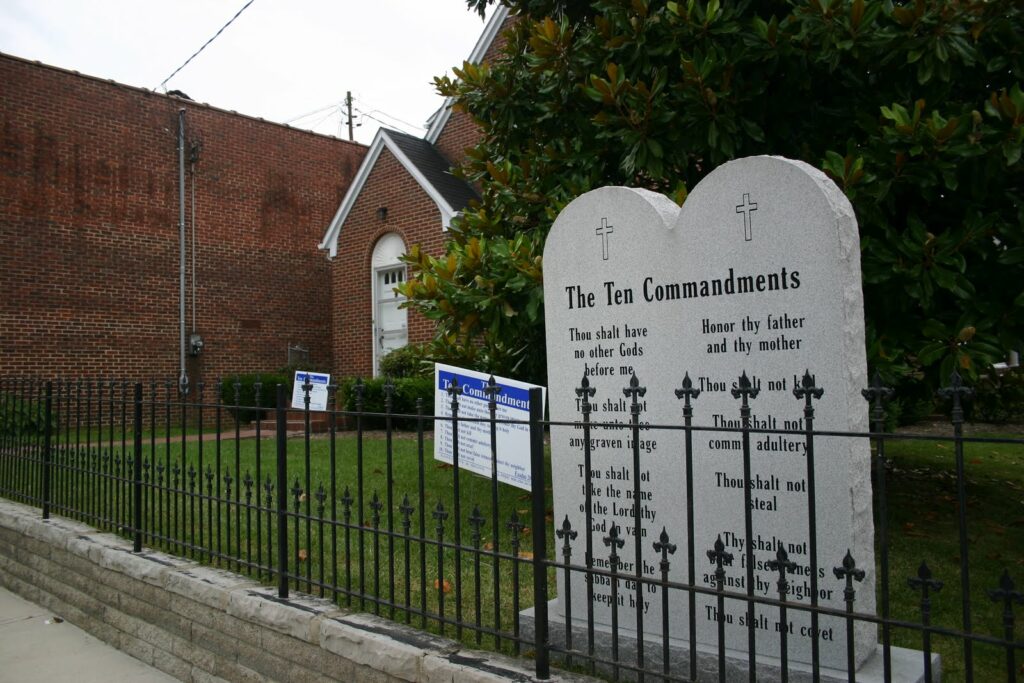 BONUS PIC FOR PETER – As mentioned above, McKee was most recently in the news when the Ten Commandments were removed from the courthouse after a federal lawsuit was filed. As a result, the Ten Commandments are EVERYWHERE in Jackson County, including this monument on private property just off the courthouse square.
BONUS PIC FOR PETER – As mentioned above, McKee was most recently in the news when the Ten Commandments were removed from the courthouse after a federal lawsuit was filed. As a result, the Ten Commandments are EVERYWHERE in Jackson County, including this monument on private property just off the courthouse square.
Estill County Courthouse – Irvine, Ky.
 So…yeah….that’s the Estill County Courthouse. A little bit of a disappointment I think, but I know it won’t be the last disappointing courthouse that I see. I don’t know much about this building, except that the cornerstone says that it was built in 1939 but the sign in front of the building says 1941. Either way, it looks like a lot of the public buildings I’ve seen from that time period (think Erickson Hall at UK).
So…yeah….that’s the Estill County Courthouse. A little bit of a disappointment I think, but I know it won’t be the last disappointing courthouse that I see. I don’t know much about this building, except that the cornerstone says that it was built in 1939 but the sign in front of the building says 1941. Either way, it looks like a lot of the public buildings I’ve seen from that time period (think Erickson Hall at UK).
The best part about visiting the Estill County Courthouse was the drive. The road from Winchester to Irvine is awesome. It’s the first during this project that I’ve really felt like I was in the mountains.

